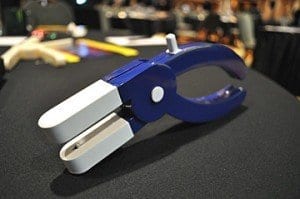“We’re developing the future of suture”
After a surgeon stitches up a patient’s abdomen, costly complications—some life-threatening—can occur. To cut down on these postoperative problems, Johns Hopkins undergraduates have invented a disposable suturing tool to guide the placement of stitches and guard against the accidental puncture of internal organs.
The student inventors have described their device, called FastStitch, as a cross between a pliers and a hole-puncher. Although the device is still in the prototype stage, the FastStitch team has already received recognition and raised more than $80,000 this year in grant and prize money to move their project forward. Among their wins were first-place finishes in University of California, Irvine, and University of Maryland business plan competitions and in the ASME International Innovation Showcase.
The FastStitch device is needed, the students say, to improve the way up to 5 million open abdominal surgeries are conducted annually in the United States alone for treatment of cancer, liver problems and other common ailments. If incisions from those procedures are not closed properly, a patient can develop complications such as infection, herniation and evisceration, all of which require additional treatment and in some cases, more surgery. Just one of these complications—herniation, in which intestinal tissue can protrude through the abdominal wall after the muscle layer splits apart—leads to $2.5 billion in additional costs annually in follow-up treatment and medical malpractice expenses, the students said.
Addressing this problem became a biomedical engineering course assignment for eight Johns Hopkins students over the past school year. They were asked to design and test a tool that would improve the way surgeons stitch together the strongest part of the abdomen, the muscle layer called the fascia, which is located just below the patient’s skin. “Doctors who have to suture the fascial layer say it can be like pushing a needle through the leather of your shoe,” said team member Luis Hererra, a sophomore biomedical engineering major from Downey, Calif. “If the needle accidentally cuts into the bowel, it can lead to a sepsis infection that can be very dangerous.”
To help prevent this, the students designed the FastStitch needle to remain housed within the jaws of the stitching tool. “You place the fascial layer between the top and bottom arms of the device,” said Sohail Zahid, of Morris Plains, N.J., leader of the student team. “Then, as you close the arms, the spring-loaded clamp is strong enough to punch the needle through the fascial layer. When this happens, the needle moves from one arm of the tool to the other.”
The device also features a visual guide to help ensure that the stitches are placed evenly, located the proper distance away from the incision and apart from one another. This should also reduce postoperative complications, the students said. The hand-size pliers-like shape was chosen because it would feel familiar to surgeons and require less training. The prototype was constructed mostly of ABS plastic, so that the instrument can be inexpensive and discarded after one use.
via Johns Hopkins University
The Latest Streaming News: Future of Suture updated minute-by-minute
Bookmark this page and come back often
Latest NEWS
Latest VIDEO








